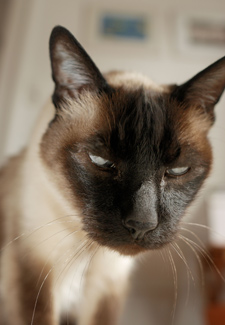Cloudy Eyes in Senior Cats: What to Watch For
Published on September 24, 2014

Achy joints, hearing loss,
deteriorating vision: Getting older is tough on all of us, including our cats.
One of the things you may notice as your cat ages is that his brilliant eyes become cloudy or hazy. That can be a normal sign of aging, or it can
be a sign of serious disease. Here’s what to look for to catch problems early so they can be treated.
Hazy Shade of Blue
We often see cat owners who
are concerned that their cats may be developing cataracts because the cats’ eyes look
cloudy. More often than not, that blueish haze is lenticular sclerosis, also
known as nuclear sclerosis.
This condition is a result of the
normal aging of the lens of the eye. New fibers form on the surface of the
lens, and the lens starts to lose moisture as the years go by. These
changes cause a blueish haze to develop.
We typically see lenticular
sclerosis start to appear in cats when they are approximately 10 years old. Unless
the cat lives to be very old, this change in the lens doesn’t seem to affect his vision. It’s not painful, and it doesn’t require treatment.
Cats and Cataracts
When the lens of the eye becomes opaque or milky in appearance, it may be a cataract. Cataracts can block light to the
retina, causing vision loss or even blindness. Fortunately, cataracts are rare in
cats.
The good news is that cataracts
aren’t painful and may not impair your cat’s ability to get around the house. Cats
usually deal well with vision loss, relying on their hearing and whiskers
to move around confidently. If cataracts are causing your cat difficulty, though, a surgeon can remove them. Removing the damaged lens and replacing it with an
artificial one can restore or improve the cat’s eyesight. A complete eye exam
is necessary beforehand to make sure the eye is otherwise healthy; for
instance, if the retina is damaged, cataract surgery won’t improve the cat’s
vision.
High Eye Pressures
Does your grandma have glaucoma? You
might be surprised to learn that your cat can develop it, too.
Glaucoma is caused by an increase in
pressure within the eye. It occurs when the eye is unable to properly drain the fluid in its front part. The fluid buildup puts pressure on
the optic nerve and can cause partial or complete blindness if left untreated.
One or both eyes can be affected.
Cats can develop primary or
secondary glaucoma. The primary form of the disease is rare and most often
seen in Burmese or Siamese cats, almost always in both eyes. Secondary glaucoma
is more common and often happens when a severe eye inflammation causes fluid to build up and block the eye’s drainage ducts. We most often see this type of glaucoma in middle-age or senior cats.
Usually the signs of glaucoma are
subtle and progressive. You may notice that one or both of your cat’s eyes are gradually
becoming cloudy and may start to look enlarged. Glaucoma is extremely painful,
so your cat may cry out or become unusually clingy.
These signs can go on for weeks or
months without being noticed, but sometimes glaucoma progresses more quickly. If
your cat is squinting and her eye is cloudy and looks enlarged, consider it an
emergency. A cat with an acute case of glaucoma can lose her eyesight within 48
hours if the condition isn’t treated right away, and damage that occurs before
treatment isn’t reversible. Glaucoma can’t be cured, but medication can help relieve the pain and reduce pressure.
Spotting Trouble
Any time your cat’s eyes cloud up,
your veterinarian should examine him sooner rather than later. Other signs to
watch for include redness, discharge, tearing, squinting, pawing at the eye,
swelling, crustiness or itchiness around the eye; an eye that seems unusually
soft or firm; a bulging or sunken eye; and loss of vision. When it comes to eye problems, “Let’s just watch it for a while” isn’t the way to go. Remember, treatment is
most successful when problems are caught early.
Many eye disorders in cats can be
treated with drops or ointments prescribed by your veterinarian. She can
show you the best way to get them into your cat’s eyes with the least amount of
distress for both of you.
The Importance of Cat Health Insurance
Your cat health insurance policy can help to offset unexpected treatment costs. These costs may include veterinary visits, prescription medications, or procedures such as imaging or surgery.
Find a personalized plan for your cat by using the insurance finder below:

